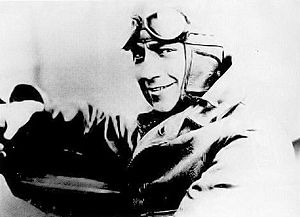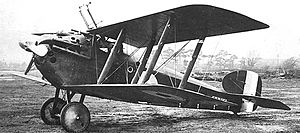Francis Warrington Gillet facts for kids
Quick facts for kids
Francis Warrington Gillet
|
|
|---|---|

Francis Warrington Gillet, 1918
|
|
| Nickname(s) | "Razors" |
| Born | 28 November 1895 Baltimore, Maryland |
| Died | 21 December 1969 (aged 74) Baltimore, Maryland |
| Allegiance | United States United Kingdom |
| Service/ |
United States Army British Army Royal Air Force |
| Years of service | 1917–1919 |
| Rank | Captain |
| Unit | Aeronautical Division, U.S. Signal Corps No. 79 Squadron RFC/RAF |
| Battles/wars | World War I |
| Awards | Distinguished Flying Cross & Bar Croix de Guerre (Belgium) |
| Other work | Returned to service during World War II |
Francis Warrington Gillet DFC* (born November 28, 1895 – died December 21, 1969) was an American pilot. He was a brave flying ace during World War I. This means he shot down many enemy aircraft.
Gillet flew for both the American and British forces. He had 20 confirmed victories in the air. This made him the top pilot flying the Sopwith Dolphin plane. He was also the second-highest scoring American pilot, just behind Eddie Rickenbacker.
Contents
Life Story of a Flying Ace
Francis Warrington Gillet was born in Baltimore, Maryland. After finishing his studies at the University of Virginia, he joined the Aeronautical Division of the U.S. Signal Corps in April 1917. He started flight training at the University of Illinois.
However, he left the U.S. program in July 1917. He then joined the Royal Flying Corps Canada. He used the name Frederick Warrington Gillet to avoid any issues. At that time, there were rules about Americans joining foreign armies.
Becoming a Fighter Pilot
Gillet completed his basic flight training in Canada. In December 1917, he became a second lieutenant. He then went to England for advanced training as a fighter pilot.
On March 29, 1918, he was sent to No. 79 Squadron RFC in France. Just a few days later, on April 1, 1918, the British Royal Flying Corps and Royal Naval Air Service joined together. They formed the new Royal Air Force (RAF).
No. 79 Squadron flew the Sopwith Dolphin. This was a unique biplane with its wings set in an unusual way. Gillet had never flown this type of plane before. He quickly learned how to fly it and became very skilled in combat.
His Victories in the Sky
Gillet scored his first victory on August 3, 1918. He destroyed a large kite balloon near Estaires. These balloons were used by the enemy to watch troop movements.
By the end of August, he had shot down two enemy aircraft. In September, he destroyed another balloon and six more planes. He continued his success in October, taking down a balloon and five aircraft. In November, he destroyed four more planes. Three of these victories happened on November 10, just one day before the war ended.
What was special about Gillet's record is that almost all his victories were "destroyed." This means the enemy aircraft or balloons were completely taken out. Many other pilots had "out of control" credits, meaning the enemy plane was forced down but not confirmed destroyed.
Gillet became an acting-captain on October 14, 1918. For a short time, he even led his squadron.
After the War
After World War I ended, Gillet left the RAF in March 1919. He went back to the United States. He also left the U.S. Army Signal Reserve Corps.
He then joined his family's business. Francis Gillet had a successful career as a businessman. He worked in banking and real estate. He passed away at the age of 74 on December 21, 1969, in Baltimore, Maryland.
Awards and Honors
Francis Warrington Gillet received several important awards for his bravery and skill.
- Distinguished Flying Cross
This British award is given for acts of courage or devotion to duty while flying in active operations against the enemy.
- Lieutenant Frederick Warrington Gillett received this award for a brave attack. He was attacking an enemy observation balloon. An enemy two-seater plane tried to stop him. Lieutenant Gillett shot down the plane. Then, he turned back to the balloon, which was being pulled down quickly. He dropped bombs near its winch and fired at it. The balloon went down, but it didn't catch fire. This was just one of his many victories.
- Bar to the Distinguished Flying Cross
A "Bar" means he received the Distinguished Flying Cross a second time.
- Lieutenant (Acting-Captain) Frederick Warrington Gillett, DFC, earned this second award. He was known for his great courage and skill. Since August 3, he had destroyed twelve enemy aircraft. On September 29, he attacked three enemy Fokker planes while on patrol. He shot down one of them, which crashed in flames.
Gillet also received the Croix de Guerre from Belgium in July 1919. This is a military award given for acts of heroism during wartime.
See also
- List of World War I flying aces from the United States


